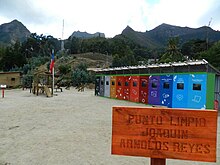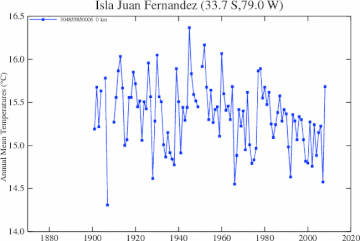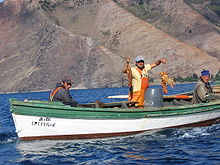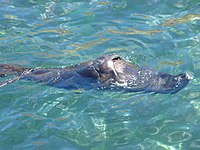Juan Fernandez Archipelago
The Juan Fernández Archipelago is a group of islands located in the South Pacific, more than 670 km west of the coast of South America. It is made up of the islands Robinson Crusoe (known until 1966 as Más a Tierra), Alejandro Selkirk (known until 1966 as Más Afuera), the islet Santa Clara and smaller islets. The archipelago is part of the territory of Chile and administratively belongs to the province and Region of Valparaíso. The Islands are famous for having served as inspiration for the novel Robinson Crusoe, written by the Englishman Daniel Defoe.
Robinson Crusoe Island, as part of the Juan Fernández archipelago, is the first national park in Chile, declared as such by the Chilean Ministry of Lands and Colonization in 1935, and since 1977 it is also a Biosphere Reserve by declaration of the UNESCO. In the Juan Fernández Archipelago National Park there is a large number of endemic species (flora and fauna), which arouses great scientific interest worldwide; many of these species are under threat of extinction. Some of these species are the Juan Fernández red hummingbird, the Juan Fernández sea lion, some cabbage species, such as Dendroseris litoralis, and ferns.
Location
It is located off the Chilean coast, at the same latitude as the port of San Antonio (located more than 670 km away), although its closest point to the mainland is in Loanco, Province of Cauquenes, where the distance is exactly of 600 km.
Geography
Its geological origin is volcanic and relatively recent: the rocks are between 1 million and 2 million years old. The climate is subtropical. The three main islands have a total area of 99.67 km². The archipelago is located between latitude 33° 36' and 33° 46' S and longitude 80° 47' and 78° 47' O. Administratively it forms the commune of Juan Fernández, belonging to the province and Region of Valparaíso in Chile. However, a constitutional reform carried out in 2007 established the archipelago as a "special territory", so that its government and administration will be governed by a special statute, contemplated in the respective constitutional organic law, to be issued.
It is part of the so-called insular Chile. The archipelago is accessed by air (2-3 hours) and sea (24-72 hours).
The islands
In 1966 the names of the two main islands and the only populated ones in the archipelago were changed: Más a Tierra to Robinson Crusoe and Más Afuera by Alejandro Selkirk.
- Robinson Crusoe Island, located in 33°38′42.50′S 78°49′23.48′ / -33.6451389, -78.8231889It has an area of 47.9 km2.
- The inhabitants of the island are descendants of Spanish settlers, and German, French and Swiss immigrants, giving shape to the current island community.
- The population of the archipelago, according to the 2002 Census, is 630 inhabitants, mainly concentrated in the village of San Juan Bautista, in the Cumberland Bay, founded in 1877 by the Swiss baron Alfred Von Rodt, who was given an authorization to exploit the island's natural resources.
- The main economic activity is marine lobster fishing (Jasus frontalis).
- Its population is decreasing; mainly because young people migrate to the continent (Chile) to get better opportunities—the island does not have an institution for the study, it only consists of a middle school—and a less isolated life.
- Alejandro Selkirk Island, located in 33°45′48.72′S 80°45′25.33′ / -33.7635333, -80.7570361It has an area of 49.5 km2. Highlights the hill of the Inocentes with a height of 1650 meters above sea level. Island where some fishermen live in it in the lobster fishing season, which is from October 1st to May 1st.
- Santa Clara Island located in 33°42′8.26′S 78°56′40.56′O / -33.7022944, -78.9446000It has an area of 2.2 km2. It is 1.5 km from Robinson Crusoe Island.
History
The archipelago was discovered by the Spanish sailor Juan Fernández, probably between 1563 and 1574. The date of its discovery is officially given as November 22, 1574. One of the main reasons, in addition to the classic exploration of the time, why Juan Fernández arrived at that place, is because he was looking for a way to avoid the Humboldt Current. His plan was to get away from the coast which is where he thought (correctly) the current was strongest, sail south with less resistance, and then sail back east without having to face the current head on. Said search was forced to do it because the current in question was traveling south of the South American continent along the Pacific Ocean coast, an extremely slow journey, since the ships had to navigate against the current.
In the 17th and XVIII was used as a hideout for pirates and corsairs. In 1749, the Spanish built Fort Santa Bárbara on the island Más a Tierra (Robinson Crusoe), as protection against pirates and corsairs. It was rebuilt in 1974 and declared a Historic Monument in 1979. At the time it was protected by six armed forts.
After the Rancagua disaster (1814), during the struggles for Independence, the island served as a prison until 1817 for the patriots Juan Egaña and others, who had to live in the so-called Cueva de los Patriotas (Historical Monument in 1979). In 1832, the archipelago was visited by Claudio Gay. During the government of Carlos Ibáñez del Campo (1927-1931), Robinson Crusoe Island was used as a prison for common and political prisoners.
World War I
In 1915, during World War I, the German protected cruiser SMS Dresden was dynamited by its own crew in Cumberland Bay, after hiding for months in Quintupeu Fjord and being pursued and attacked by the English ships HMS Cornwall HMS Glasgow and HMS Kent. She was declared a Historical Monument in 1985. She is sunk 65 meters deep. In the cemetery of San Juan Bautista (Chile) the remains of some members of her crew are buried. The most famous of her crew members was Lieutenant Wilhelm Canaris, who would be Chief of the German Counterintelligence (Abwehr), in World War II.
The area of Plazoleta El Yunque was the place that the German sailor Hugo Weber Fachinger chose as his home during the 1930s. He had previously been shipwrecked off Cumberland Bay in the SMS Dresden during the First World War. He was affectionately baptized as the German Robinson by the community of San Juan Bautista (Chile) and became the first island ranger in Chile. He wrote the book Signalmaat Weber, published in Germany, where he gave an account of his Robinsonian adventure. During World War II, the sailor was accused of acting as a spy and of informing the Nazi organization about the movement of ships through the Pacific Ocean through his radio transmitter. Faced with the repudiation of the island's population, the Chilean government and the investigation of Nazi activities in Chile, he and his wife escaped from Más to Tierra. A film made about him (Ein Robinson) during his stay on the island was considered Nazi propaganda and outlawed. The same thing happened with his book in Germany.
National Park
In 1935 the three main islands of the archipelago were declared a national park of the Juan Fernández Archipelago with an extension of approximately 9,967 hectares, and declared a World Biosphere Reserve by Unesco in 1977.
Treasure
In 2005, Juan Fernández Island made international headlines due to the announcement that the GPR aradar robot TR araña, dubbed Arturito by the press, would have found Juan Fernández's treasure, supposedly buried around 1715 by the Spanish navigator Juan Esteban Ubilla Echeverría, and later unearthed and reburied by the English sailor Cornelius Webb and which would consist of about 600 barrels with gold coins, which in current money could be equivalent to about 10,000 million dollars.
The alleged find went around the world and was published in newspapers, blogs and websites in the United States, Europe and Asia.
Representatives of the security company Wagner, owner of the artifact, held negotiations with local and regional authorities headed by Mayor Luis Guastavino to coordinate the extraction of the treasure, but the project was delayed and finally came to nothing, after scientists and various articles in the press questioned the reliability of the GPR. The treasure, if found, would contain, among other things, twelve papal rings, the Key to the Wailing Wall, one of the most famous jewels in history, known as the Rose of the Winds, and it is even said that there would also be part of it. of the treasures of the Inca Empire; Thus, legend has it that the necklace of Atahualpa's wife would be buried there.
2010 Tsunami
In the early morning of February 27, 2010, at 03:34 local time, UTC-3, an 8.8-magnitude earthquake struck the south-central zone of Chile.
The earthquake, which as such went unnoticed in the archipelago, triggered a tsunami that reached Juan Fernández with waves of up to 15 meters high, which destroyed the populations of this archipelago. In Juan Fernández, the tsunami fatalities were 10 dead and 6 missing. Deficiencies in the alarm and warning systems in the area, as well as institutional errors that are still being investigated, meant that the population of Juan Fernández was not warned in a timely manner to save themselves from the devastating catastrophe that caused the entry of the sea in an extension of more than three kilometers.
2011 Air Tragedy
On September 2, 2011, a CASA C-212 Aviocar military plane of the Chilean Air Force (FACh) crashed after a failed landing attempt at the Juan Fernández Aerodrome (Robinson Crusoe Island). The 18 passengers and 3 crew members of the aircraft were part of a team of professionals who were heading to the archipelago with the aim of collaborating with the reconstruction after the 2010 tsunami. Unfortunately, all of them died when the plane crashed into the sea for reasons still not established. Among the deceased are members of a journalistic team from Televisión Nacional de Chile, including the host of the program Buenos días a todos, Felipe Camiroaga and the journalist Roberto Bruce, members of the reconstruction group "Desafío Levantemos Chile", headed by Felipe Cubillos, officials from the National Council for Culture and the Arts and personnel from the Chilean Air Force. After 5 days of the accident, only 4 bodies and some remains (limbs) had been recovered and 6 people identified, but the whereabouts of the rest of the victims were unknown. On September 9, another 5 bodies (human remains) were found, among them, the entertainer Felipe Camiroaga and the businessman and philanthropist Felipe Cubillos. By January 18, the Government reports that the body of Romina Irarrázabal, also a victim, has been identified. To date, all that remains is to find the remains of 4 more deceased. Joaquín Arnolds Reyes also died in this accident, in whose name the first insular Clean Point of Chile was inaugurated, on March 12, 2012, thanks to the joint work of Desafío Levantemos Chile and TriCiclos, a sustainability company of which Joaquín was a partner. founder.
Juan Fernandez Reef
Although Chile is not well known for its reefs and corals, in certain areas they do exist; one of them is the archipelago, and in greater abundance on the island of Robinson Crusoe, where large underwater spaces ranging from 4 to 25 mbnm are located, which contain a great variety of fish, corals, amoebas, mollusks, among others. that have not been registered. There is no registry of the species, which perhaps has contributed to their preservation and almost virgin existence.
Flora and fauna
In recent years the work of a Chilean photographer Eduardo Sorensen on the island has borne fruit, generating a project integrated by himself and Fernando Luchsinger, to demonstrate and photograph the rich marine flora and fauna of Chile, because the Chilean sea It is not gray as you think.
Climate
Its climate is subtropical maritime with high environmental humidity, with an average annual temperature of 15.3 °C. The average annual precipitation reaches 1,041.5 mm; the rains decrease between October and February.
Your Meteorological Station is not being affected by the thermal spot of the city, as it happens in the vast majority of meteorological stations near large populations.
| Month | Ene. | Feb. | Mar. | Open up. | May. | Jun. | Jul. | Ago. | Sep. | Oct. | Nov. | Dec. | Annual |
|---|---|---|---|---|---|---|---|---|---|---|---|---|---|
| Temp. max. abs. (°C) | 28.8 | 27.8 | 27.0 | 26.0 | 24.8 | 22.2 | 22.6 | 24.4 | 21.8 | 23.5 | 25.2 | 26.9 | 28.8 |
| Average temperature (°C) | 21.5 | 21.4 | 21.1 | 19.3 | 17.6 | 16.2 | 15.0 | 14.8 | 15.0 | 16.0 | 17.6 | 19.8 | 17.9 |
| Average temperature (°C) | 18.5 | 18.5 | 18.1 | 16.5 | 15.0 | 13.6 | 12.5 | 12.2 | 12.3 | 13.3 | 14.8 | 16.9 | 15.2 |
| Temp. medium (°C) | 16.4 | 16.6 | 16.1 | 14.6 | 13.1 | 11.8 | 10.8 | 10.4 | 10.4 | 11.3 | 12.7 | 14.7 | 13.2 |
| Temp. min. abs. (°C) | 10.6 | 4.2 | 9.0 | 4.2 | 4.6 | 4.8 | 5.0 | 3.0 | 5.0 | 6.2 | 7.3 | 9.2 | 3.0 |
| Total precipitation (mm) | 32.5 | 34.5 | 60.3 | 91.1 | 160.8 | 180.1 | 160.2 | 126.3 | 87.7 | 54.1 | 35.1 | 24.1 | 1046.8 |
| Precipitation days (≥ 0.1 mm) | 11 | 10 | 13 | 15 | 21 | 23 | 21 | 19 | 16 | 14 | 10 | 10 | 183 |
| Hours of sun | 248.0 | 209.1 | 158.1 | 123.0 | 108.5 | 99.0 | 93.0 | 105.4 | 147.0 | 204.6 | 249.0 | 260.4 | 2005.1 |
| Relative humidity (%) | 73 | 73 | 73 | 77 | 78 | 78 | 79 | 77 | 77 | 76 | 74 | 73 | 76 |
| Source: Chilean Meteorological Directorate | |||||||||||||
Wildlife
Birds
- Armored (Geranoaetus polyosoma exsul): endemic bird subspecies of the island Alejandro Selkirk, sometimes treated as a species different from the eagle. It feeds on introduced mammals, lamps and carrion.
- Cachudito de Juan Fernández (Anairetes fernandezianus): Endemic bird of Robinson Crusoe Island, inhabits forests and is threatened by invasive species.
- Cernícalo de Juan Fernández (Falco sparverius fernandensis): rapacious bird that feeds on common doves that live on cliffs, mice and rabbits.
- Masa Outside Churrete (Cinclodes oustaleti baeckstroemii): ave passeriforme endemic of the island Alejandro Selkirk. It is in danger of extinction, fires and over-storage by goats are their main threats.
- Neque (Asio flammeus): native species. It is a rapacious bird, a relative of lettuce, which helps control the abundant population of rabbits and rats present on Robinson Crusoe Island.
- Picaflor or Tinguerita or Tíngara (Sephanoides sephaniodes): species of hummingbird that migrates from the continent to the archipelago; it feeds on the same flowers as red picaflor but is smaller.
- Picaflor de Juan Fernández (Sephanoides fernandensis): This is the most characteristic species of the archipelago, it is an endemic hummingbird that receives the name due to the red plumage presented by the male, although the female is green. Its current population is estimated at no more than 400 specimens, so it is considered endangered.
- Bloody Masa Outside (Aphrastura massouterae): endemic of the island Alejandro Selkirk. Lives in areas over 800m. n. m.with a cover of trees and ferns about 50%. Predominantly they are found within the plant cover. In grave danger of extinction, it is the most threatened Chilean bird.
Invertebrates
- Flying spider (Selenopidae): from mainland Chile, colonized the archipelago about two million years ago. It travels through air currents through silk threads that behave like a candle. Darwin documented his presence on board the HMS Beagle 100 kilometres from firm land.
- Golden Crab (Chaceon chilensis): Juan Fernández's golden crab is of a light brown color uniform and a quadrangular shell. The capture of this crustacean was characterized by the almost absolute presence of males, where its sizes varied between 84 to 147 mm of chest céfalo length, with an average weight of 863 g.
- Jaiba corridor (Leptograpsus variegatus): you can find it in rocks where it consumes microscopic algae that collects with its tweezers in alternate form.
- Lobster of Juan Fernández (Jasus frontalis): is the main economic resource of this archipelago. This crustacean lives mainly in rocky backgrounds, especially in natural caves, where it is hidden to avoid currents. Due to its overexploitation and its slow development to reach an adult (approximately 6 years), its capture is subject to restrictions.
- Loco de Juan Fernández (Concholepas concholepas fernandezianus): is a subspecies of the mainland madman. It is distributed approximately to 15 meters deep between the algae, preferably in the southwest area of the island.
Mammals
- Cabra de Juan Fernández (Capra aegagrus hircus): This introduced species comes from Europe and is at liberty in the archipelago; because of this, the evolution originated brown goats with a black cross in the spine.
- Lobo fino de Juan Fernández or Sea lion of two hairs (Arctophoca philippii philippii): is the only endemic mammal of Juan Fernández. Although there was a population of 5 million before, its population is now estimated to be around 60 000 copies. As in other species of sea lions, in the colonies of these, a dominant male controls a female harem.
Tourism
Between 1704 and 1709, Robinson Crusoe Island was home to Scottish sailor Alexander Selkirk, who inspired Daniel Defoe's novel Robinson Crusoe—however, the novel's action does not take place on the actual location of Selkirk's incident, but on an island located near the mouths of the Orinoco River. The visitor is directed to see the cave where Selkirk supposedly lived. This was the reason for the name change of the two main islands (Más a Tierra and Más Afuera) in 1966.
Contenido relacionado
Provinces of Argentina
Soviet Union space program
Pontius Pilate








